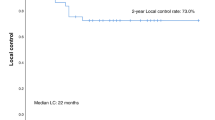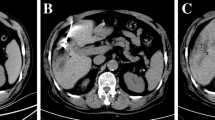Abstract
Hepatocellular carcinoma (HCC) is an especially frequent malignancy in China. Radiofrequency ablation, percutaneous ethanol injection, transarterial chemoembolization, cryoablation, microwave coagulation, and laser-induced interstitial thermotherapy all offer potential local tumor control and occasionally achieve long-term disease-free survival. High-intensity focused ultrasound (HIFU), as a noninvasive therapy, can be applied to treat tumors that are difficult to treat with other techniques. The preliminary results of HIFU in clinical studies are encouraging. The aims of this investigation were to assess the efficacy of the system in obtaining necrosis of the target tissue and to determine whether HIFU ablation is hazardous to adjacent major blood vessels. Over 7 years, thirty-nine patients with HCC were enrolled in this investigation. The inferior vena cava (IVC), main hepatic vein branches, and the portal vein and its main branches were evaluated. The distance between tumor and main blood vessel was less than 1 cm in all these enrolled patients. Contrast-enhanced MRI was used to evaluate the perfusion of tumors and major blood vessels. We conducted HIFU ablation for the treatment of 39 patients with 42 tumors, with each tumor measuring 7.4 ± 4.3 (1.5–22) cm in its greatest dimension. Among the 39 patients, 23 were males and 16 females. The average age was 53.2 years (range 25–77 years). Thirty-seven patients had a solitary lesion, one had two lesions, and the remaining one had three lesions. Nineteen lesions were located in the right lobe of liver, 18 in the left lobe, and 5 in both right and left lobes. Among the 42 tumors, 25 were adjacent to 1 blood vessel, 12 adjacent to 2 main vessels, 2 adjacent to 3 main vessels, and 1 adjacent to 4 main vessels. Twenty-one of the 42 tumors were completely ablated, while the rest of the tumors were ablated by more than 50% of lesion volume after one session of HIFU. No major blood vessel injury was observed in any subject after 23.8 ± 17.2 months follow-up. HIFU can achieve complete tumor necrosis even when the lesion is located adjacent to the major hepatic blood vessels. Short-term and long-term follow-up results show that HIFU can be safely used to ablate the tumors adjacent to major vessels.





Similar content being viewed by others
References
Makuuchi M, Kosuge T, Takayama T, Yamazaki S, Kakazu T, Miyagawa S, Kawasaki S (1993) Surgery for small liver cancers. Semin Surg Oncol 9:298–304
Livraghi T, Makuuchi M, Buscarini L (1997) Diagnosis and treatment of hepatocellular carcinoma. Greenwich Medical Media, London
Ng KK, Lam CM, Poon RT, Shek TW, Fan ST, Wong J (2004) Delayed portal vein thrombosis after experimental radiofrequency ablation near the main portal vein. Br J Surg 91:632–639
Frich L, Hol PK, Roy S, Mala T, Edwin B, Clausen OP, Gladhaug IP (2006) Experimental hepatic radiofrequency ablation using wet electrodes: electrode-to-vessel distance is a significant predictor for delayed portal vein thrombosis. Eur Radiol 16:1990–1999
Lynn JG, Zwemer RL, Chick AJ (1942) A new method for the generation and use of focused ultrasound in experiment biology. J Gen Physiol 26:179–193
Fry WJ, Mosberg WH Jr, Barnard JW, Fry FJ (1954) Production of focal destructive lesions in the central nervous system with ultrasound. J Neurosurg 11:471–478
Wu F, Wang ZB, Chen WZ, Zhu H, Bai J, Zou JZ, Li KQ, Jin CB, Xie FL, Su HB (2004) Extracorporeal high intensity focused ultrasound ablation in the treatment of patients with large hepatocellular carcinoma. Ann Surg Oncol 11:1061–1069
Wu F, Wang ZB, Chen WZ, Wang W, Gui Y, Zhang M, Zheng G, Zhou Y, Xu G, Li M, Zhang C, Ye H, Feng R (2004) Extracorporeal high intensity focused ultrasound ablation in the treatment of 1038 patients with solid carcinomas in China: an overview. Ultrason Sonochem 11:149–154
Arii S, Yamaoka Y, Futagawa S, Inoue K, Kobayashi K, Kojiro M, Makuuchi M, Nakamura Y, Okita K, Yamada R (2000) Results of surgical and nonsurgical treatment for small-sized hepatocellular carcinomas: a retrospective and nationwide survey in Japan. The Liver Cancer Study Group of Japan. Hepatology 32:1224–1229
Allgaier HP, Deibert P, Zuber I, Olschewski M, Blum HE (1999) Percutaneous radiofrequency interstitial thermal ablation of small hepatocellular carcinoma. Lancet 353:1676–1677
Livraghi T, Lazzaroni S, Pellicano S, Ravasi S, Torzilli G, Vettori C (1993) Percutaneous ethanol injection of hepatic tumours: single-session therapy with general anesthesia. AJR Am J Roentgenol 161:1065–1069
Liang HL, Yang CF, Pan HB, Lai KH, Cheng JS, Lo GH, Chen CK, Lai PH (2000) Small hepatocellular carcinoma: safety and efficacy of single high-dose percutaneous acetic acid injection for treatment. Radiology 214:769–774
Patterson EJ, Scudamore CH, Owen DA, Nagy AG, Buczkowski AK (1998) Radiofrequency ablation of porcine liver in vivo: effects of blood flow and treatment time on lesion size. Ann Surg 227:559–565
Hori T, Nagata K, Hasuike S, Onaga M, Motoda M, Moriuchi A, Iwakiri H, Uto H, Kato J, Ido A, Hayashi K, Tsubouchi H (2003) Risk factors for the local recurrence of hepatocellular carcinoma after a single session of percutaneous radiofrequency ablation. J Gastroenterol 38:977–981
Wu F, Wang ZB, Lu P, Xu ZL, Chen WZ, Zhu H, Jin CB (2004) Activated anti-tumourtumour immunity in cancer patients after high intensity focused ultrasound ablation. Ultrasound Med Biol 30:1217–1222
Wingo PA, Tong T, Bolden S (1995) Cancer statistics, 1995. CA Cancer J Clin 45:8–30
Pelletier G, Ducreux M, Gay F, Luboinski M, Hagege H, Dao T, Van Steenbergen W, Buffet C, Rougier P, Adler M, Pignon JP, Roche A (1998) Treatment of unresectable hepatocellular carcinoma with lipiodol chemoembolization: a multicenter randomized trial. Groupe CHC. J Hepatol 29:129–134
Lencioni R, Cioni D, Crocetti L, Franchini C, Pina CD, Lera J, Bartolozzi C (2005) Early-stage hepatocellular carcinoma in patients with cirrhosis: long-term results of percutaneous image-guided radiofrequency ablation. Radiology 234:961–967
Bruix J, Llovet JM, Castells A, Montana X, Bru C, Ayuso MC, Vilana R, Rodes J (1998) Transarterial embolization versus symptomatic treatment in patients with advanced hepatocellular carcinoma: results of a randomized, controlled trial in a single institution. Hepatology 27:1578–1583
Takayasu K, Arii S, Ikai I, Omata M, Okita K, Ichida T, Matsuyama Y, Nakanuma Y, Kojiro M, Makuuchi M, Yamaoka Y (2006) Prospective cohort study of transarterial chemoembolization for unresectable hepatocellular carcinoma in 8510 patients. Gastroenterology 131:461–469
Wu F, Wang ZB, Chen WZ, Zou JZ, Bai J, Zhu H, Li KQ, Jin CB, Xie FL, Su HB (2005) Advanced hepatocellular carcinoma: treatment with high-intensity focused ultrasound ablation combined with transcatheter arterial embolization. Radiology 235:659–667
Yamagiwa K, Shiraki K, Yamakado K, Mizuno S, Hori T, Yagi S, Hamada T, Iida T, Nakamura I, Fujii K, Usui M, Isaji S, Ito K, Tagawa S, Takeda K, Yokoi H, Noguchi T (2008) Survival rates according to the Cancer of the Liver Italian Program scores of 345 hepatocellular carcinoma patients after multimodality treatments during a 10-year period in a retrospective study. J Gastroenterol Hepatol 23(3):482–490 Epub 2007 Dec 13
Kopelman D, Papa M (2007) Magnetic resonance-guided focused ultrasound surgery for the noninvasive curative ablation of tumors and palliative treatments: a review. Ann Surg Oncol 14:1540–1550
Author information
Authors and Affiliations
Corresponding author
Additional information
Lian Zhang and Hui Zhu contributed equally to this research, which was supported by the National Natural Science Foundation of China (grant no. 30171060).
Rights and permissions
About this article
Cite this article
Zhang, L., Zhu, H., Jin, C. et al. High-intensity focused ultrasound (HIFU): effective and safe therapy for hepatocellular carcinoma adjacent to major hepatic veins. Eur Radiol 19, 437–445 (2009). https://doi.org/10.1007/s00330-008-1137-0
Received:
Revised:
Accepted:
Published:
Issue Date:
DOI: https://doi.org/10.1007/s00330-008-1137-0




